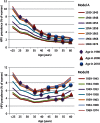A cohort effect of the sexual revolution may be masking an increase in human papillomavirus detection at menopause in the United States
- PMID: 23242540
- PMCID: PMC3532829
- DOI: 10.1093/infdis/jis660
A cohort effect of the sexual revolution may be masking an increase in human papillomavirus detection at menopause in the United States
Abstract
Background: Cohort effects, new sex partnerships, and human papillomavirus (HPV) reactivation have been posited as explanations for the bimodal age-specific HPV prevalence observed in some populations; no studies have systematically evaluated the reasons for the lack of a second peak in the United States.
Methods: A cohort of 843 women aged 35-60 years were enrolled into a 2-year, semiannual follow-up study. Age-specific HPV prevalence was estimated in strata defined by a lower risk of prior infection (<5 self-reported lifetime sex partners) and a higher risk of prior infection (≥ 5 lifetime sex partners). The interaction between age and lifetime sex partners was tested using likelihood ratio statistics. Population attributable risk (PAR) was estimated using Levin's formula.
Results: The age-specific prevalence of 14 high-risk HPV genotypes (HR-HPV) declined with age among women with <5 lifetime sex partners but not among women with ≥ 5 lifetime sex partners (P = .01 for interaction). The PAR for HR-HPV due to ≥ 5 lifetime sex partners was higher among older women (87.2%), compared with younger women (28.0%). In contrast, the PAR associated with a new sex partner was 28% among women aged 35-49 years and 7.7% among women aged 50-60 years.
Conclusions: A lower cumulative probability of HPV infection among women with a sexual debut before the sexual revolution may be masking an age-related increase in HPV reactivation in the United States.
Figures




Comment in
-
Human papillomavirus in older women: new infection or reactivation?J Infect Dis. 2013 Jan 15;207(2):211-2. doi: 10.1093/infdis/jis662. Epub 2012 Dec 12. J Infect Dis. 2013. PMID: 23242539 Free PMC article. No abstract available.
References
-
- Smith JS, Melendy A, Rana RK, Pimenta JM. Age-Specific Prevalence of Infection with Human Papillomavirus in Females: A Global Review. Journal of Adolescent Health. 2008;43:S5.e1–62. - PubMed
-
- de Sanjose S, Diaz M, Castellsague X, et al. Worldwide prevalence and genotype distribution of cervical human papillomavirus DNA in women with normal cytology: a meta-analysis. Lancet Infect Dis. 2007;7:453–9. - PubMed
-
- Franceschi S, Herrero R, Clifford GM, et al. Variations in the age-specific curves of human papillomavirus prevalence in women worldwide. Int J Cancer. 2006;119:2677–84. - PubMed
-
- Bruni L, Diaz M, Castellsagué M, Ferrer E, Bosch FX, de Sanjosé S. Cervical human papillomavirus prevalence in 5 continents: meta-analysis of 1 Million women with normal cytological findings. Journal of Infectious Diseases. 2010;202:1789–99. - PubMed
-
- Castle PE, Fetterman B, Thomas Cox J, et al. The age-specific relationships of abnormal cytology and human papillomavirus DNA results to the risk of cervical precancer and cancer. Obstetrics & Gynecology. 2010;116:76–84. - PubMed
Publication types
MeSH terms
Grants and funding
LinkOut - more resources
Full Text Sources
Other Literature Sources
Medical

